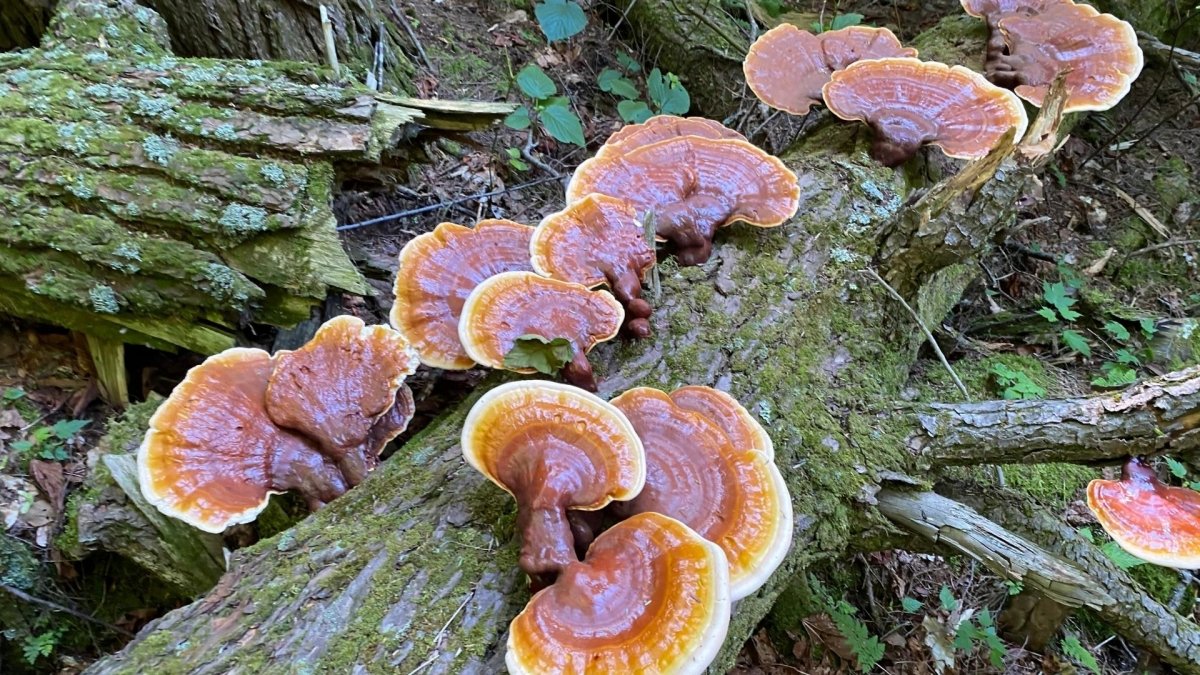Reishi Mushroom Look-Alikes: Identification and Forage Guide
The unique features of Reishi mushrooms include a reddish-brown or black cap with a shiny or matte texture, small pores, or a smooth surface, and a fan or kidney shape. Their stem is short, stubby, and sometimes absent or off-center. It is important to note Reishi Mushroom Look-Alikes to avoid mistakenly harvesting poisonous mushrooms.
These mushrooms have long been used in traditional Chinese medicine for their healing properties, also known as lingzhi or Ganoderma lucidum. This article will discuss the differences between Reishi mushrooms and similar-looking fungi, as well as their potential health benefits[1].
According to mycologist Paul Stamets, “When it comes to reishi look alikes, the best advice is to not take any chances. If in doubt, throw it out!”
In this article:
How to Identify a Reishi Mushroom?
For those new to mushroom identification, identifying Reishi mushrooms from similar-looking species can be challenging. Here are some useful tips:
- Look at the cap – They have a reddish-brown, woody cap that is kidney-shaped and shiny.
- Examine the underside of the cap – Check the white pores or lines on the underside of the cap.
- Check the stem – They have a short, off-center stem without gills.
- Smell the mushroom – They have a slightly sweet, woody, and earthy scent.
- Seek expert advice – If you’re unsure about the identification of a mushroom, consult an expert, such as a mycologist, a mushroom expert, or a knowledgeable herbalist.
What are Reishi Mushrooms Look-Alikes?
1. Ganoderma tsugae
Ganoderma tsugae also known as hemlock varnish shelf, is a type of polypore mushroom that grows on coniferous trees in North America. It shares many physical similarities with the Reishi mushroom, making it a common look-alike. Like Reishi, it contains triterpenes and polysaccharides, which are believed to have anti-inflammatory and antioxidant properties. As a natural health supplement, it’s commonly found in teas and supplements.
2. Ganoderma curtisii
Ganoderma curtisii, is another Reishi mushroom look-alike, and is typically found in tropical and subtropical regions. It belongs to the same genus as reishi and grows on dying or dead hardwood trees, such as oak and maple. The mushroom has a reddish-brown cap and a white pore surface. In traditional herbal medicine, it is believed to have potential health benefits.
3. Artist’s Conk
The artist’s conk mushroom (Ganoderma applanatum), has a light brown or gray cap with brown pores underneath, while the reishi mushroom has a red-brown cap with white pores. Additionally, the artist’s conk mushroom is more circular in shape than the reishi. However, both mushrooms have a fan-like shape and a white to yellowish-brown pore surface. It’s important to note that the underside of the artist’s conk mushroom is typically reddish-brown.
According to mycologist David Arora, “The Artist’s Conk is an excellent edible, but it’s not nearly as medicinal as the Reishi[2].”
4. Velvet Foot
The velvet foot mushroom (Flammulina velutipes), has a texture similar to reishi but has a small brown cap and long, thin stem. In comparison, the reishi has a larger, flat cap and short, thick stem.
5. Birch Polypore
The birch polypore mushroom (Piptoporus betulinus), is often mistaken for reishi due to their similar texture. However, there are key differences, such as the light brown or yellow-brown cap with white pores on its underside. In contrast, reishi has a red-brown cap with white pores.
Reishi Mushroom Poisonous Look-Alikes
Luckily, there are no known poisonous Reishi mushroom look-alikes, but some mushrooms that resemble it may cause stomach upset or allergic reactions in certain people. It’s crucial to be cautious when searching for mushrooms, as certain species can share features with Reishi. It’s recommended to seek the guidance of an experienced forager or expert to ensure accurate identification of mushrooms.
As noted by mycologist Christopher Hobbs, “The healing properties of Reishi have been extensively researched, and there are no known toxic look-alikes” (Hobbs, 2013)[5].
Consuming excessive amounts of any mushroom, including Reishi, may cause stomach discomfort or allergic reactions in some individuals. It’s critical to eat mushrooms in moderation and to consult a healthcare professional before incorporating them into your diet, particularly if you have an existing medical condition or are on medication.
How to Tell the Difference Between Red Belted Conk and Reishi?
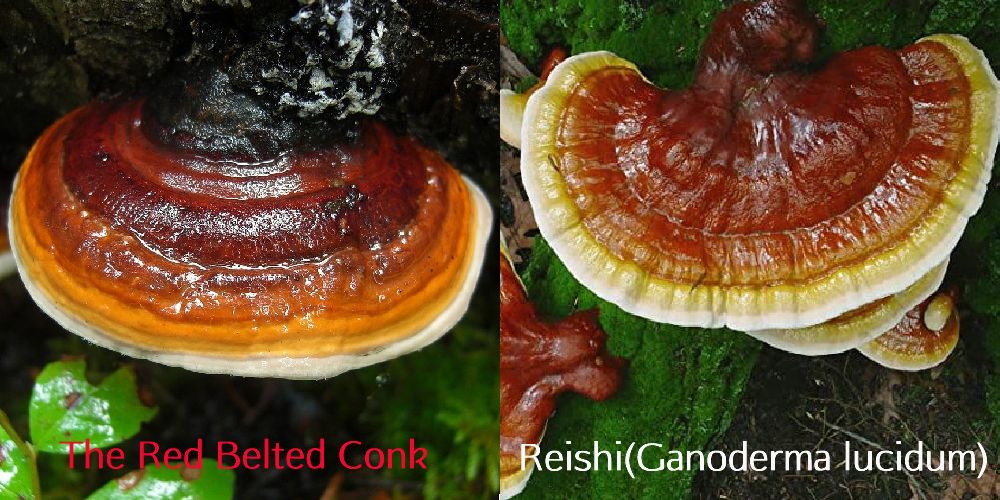
Red-belted conk is a type of bracket fungus, scientifically known as Fomitopsis pinicola. It is a polypore mushroom that is typically found growing on the trunks of dead or dying conifer trees, such as pine, spruce, and fir.
Red-belted conk and reishi are both known for their medicinal properties. However, they have distinct characteristics that can help differentiate between the two species.
The following table outlines the key differences:
| Characteristic | Red Belted Conk | Reishi Mushroom |
|---|---|---|
| Shape | Hoof or shelf-shaped body | Kidney or fan-shaped cap with a central depression |
| Size | Ranges from a few inches to over a foot in diameter | Ranges from a few inches to over a foot in diameter |
| Color | A bright red or orange band around the outer edge, with a lighter coloration ranging from tan to yellowish-red | Tan, red, or yellowish-brown cap with a woody surface |
| Texture | Pliable, rubbery feel with a smooth, leathery surface | Brittle, tough, and fibrous surface |
| Stem | Short and stubby, often attached off-center | Short and stubby, sometimes absent |
Harvesting Reishi Mushrooms
If you’re a mushroom enthusiast and want to harvest Reishi mushrooms, it’s important to be able to differentiate them from their look-alikes, and you need to know the best practices to get the most out of your harvest[3].
These mushrooms grow on hardwood trees like oak and maple in wooded areas. To identify mature Reishi mushrooms, look for a flat, kidney-shaped cap with a distinct red-brown hue. In contrast, young Reishi mushrooms have a more rounded cap and appear lighter in color.
Harvest them in the late summer or early fall when they’re fully mature. If you are harvesting too early or too late can result in undeveloped or infested mushrooms. Keep an eye on their growth and harvest them at the optimal time.
Additionally, when harvesting them, use a sharp knife or scissors to cut the stem at the base of the mushroom. This ensures the mycelium remains in the tree and continues to produce mushrooms. Avoid pulling the mushroom off the tree as it can damage the mycelium and affect future growth.
After harvesting, dry the Reishi mushrooms before use. Place them in a warm, dry location like an oven or dehydrator for several hours until they’re fully dry. Store them in an airtight container for future use.
Exploring Reishi Mushroom Look-Alikes
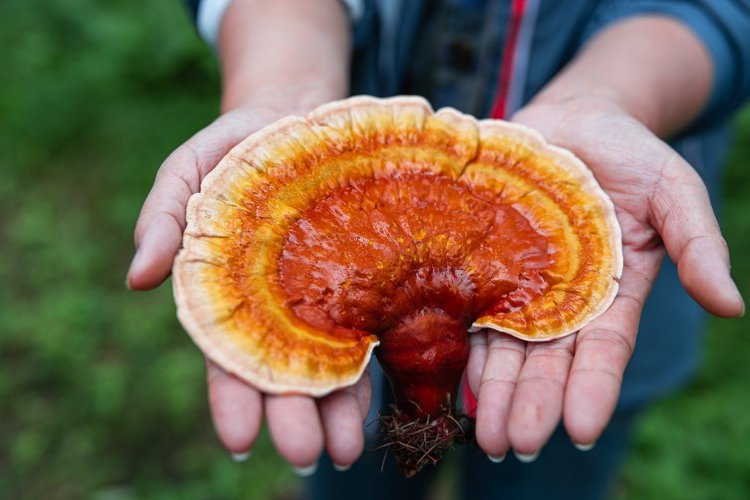
Reishi vs Ganoderma
What is the Difference between Reishi and Ganoderma? These two mushrooms are the same species, but East Asians commonly use “reishi,” while “Ganoderma” is more popular in Western countries. The Ganoderma lucidum is the most commonly grown and used for medicinal purposes among the various Ganoderma species[4].
While these mushrooms belong to the same genus, there are noticeable differences between them. Let’s take a look at the primary differences:
| Aspect | Reishi (Ganoderma lingzhi) | Ganoderma (Genus) |
|---|---|---|
| Common Names | Reishi, Lingzhi, Mannentake | Ganoderma, Lingzhi |
| Scientific Name | Ganoderma lingzhi | Genus encompassing multiple species |
| Habitat | Grows on hardwood trees, mainly in Asia | Various species found globally |
| Appearance | Fan-shaped or kidney-shaped, distinct glossy surface | Varies by species, usually kidney-shaped, with a woody texture |
| Traditional Use | An integral part of traditional Chinese medicine for centuries | Utilized in various traditional medicine systems |
| Active Compounds | Contains polysaccharides, triterpenes, and other bioactive compounds | Similar compounds found in different species |
| Health Benefits | Immune system support, stress reduction, and overall well-being | Adaptogenic properties, potential benefits for various health conditions |
| Flavor Profile | Bitter and earthy | Bitter and woody |
| Culinary Use | Often used in teas, soups, and tinctures | Less common in culinary applications |
| Availability | Cultivated and available in various forms (powders, extracts) | Available in forms like capsules, extracts, and supplements |
| Research Studies | Numerous studies on its potential health benefits | The research focused on different species and their effects |
Red Reishi Vs. Reishi
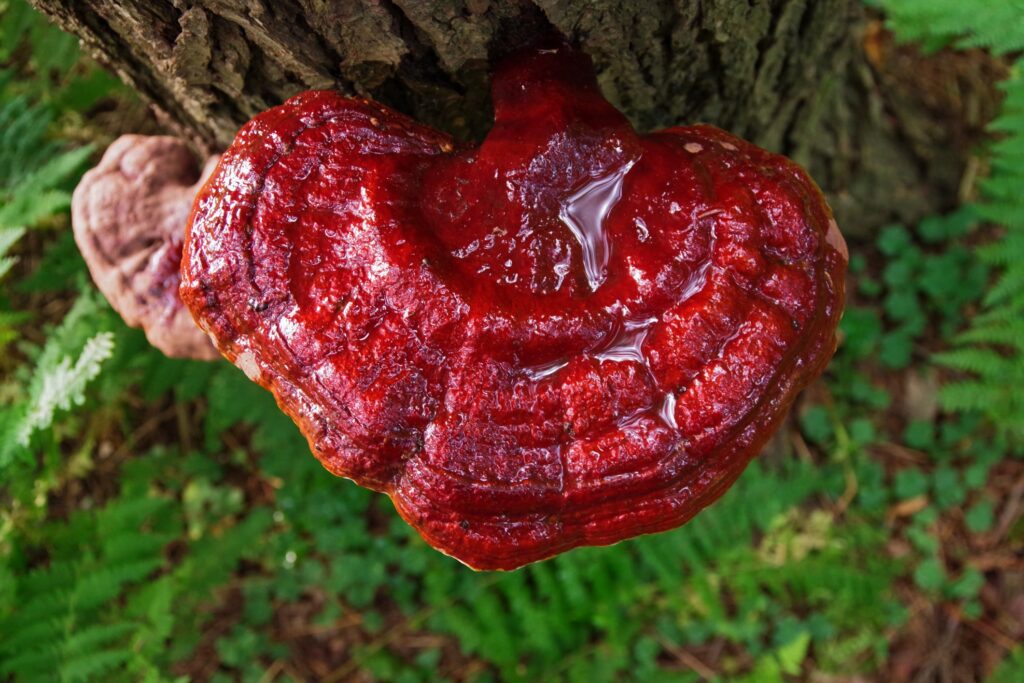
They are both referring to the same mushroom species. Red reishi mushroom is a type of Ganoderma lucidum, a type of mushroom grown under specific conditions. It is typically grown on wood logs and has a color range of dark red to brown. In traditional Chinese medicine, Red Reishi is more potent than regular reishi.
The following table outlines the significant differences between the two:
| Red Reishi | Reishi | |
|---|---|---|
| Definition | A specific strain of Ganoderma lucidum | The entire species of Ganoderma lucidum |
| Appearance | Darker, reddish-brown color with a thicker cap | Can range from pale white to dark brown |
| Cultivation | Grown under specific conditions to enhance potency | Can be cultivated using different methods |
| Medicinal Properties | May have higher potency due to specific growing conditions | May vary depending on the strain and cultivation method |
| Uses | Often used to support immune function, reduce inflammation, and improve cardiovascular health | Has a range of potential medicinal uses, depending on the strain and form |
Chaga Vs. Reishi
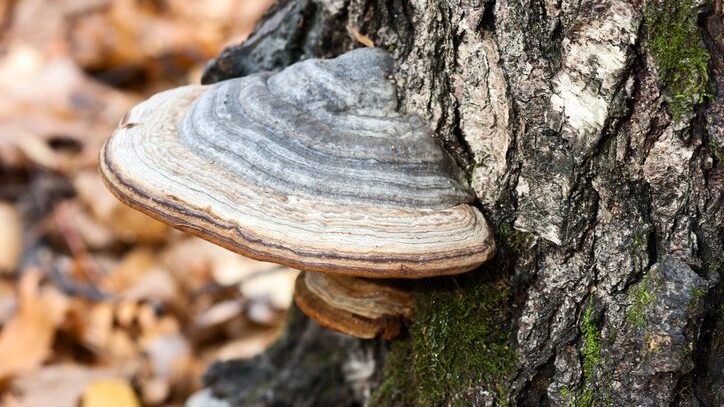
The Chaga mushroom (Inonotus obliquus) is a medicinal mushroom that’s commonly compared to reishi because of its similar health benefits and traditional use[6]. It has a black, charcoal-like appearance and grows on birch trees in cold regions like northern Europe, Russia, and Korea.
Here are some key differences between the Chaga and Reishi mushrooms:
| Chaga | Reishi | |
| Scientific name | Inonotus obliquus | Ganoderma lucidum |
| Appearance | Dark, black, and hard with a crusty exterior and an orange-brown interior. | Flat, fan-shaped, with a reddish-brown or black surface and white, woody undersurface. |
| Habitat | Grows on birch trees, mainly in cold climates such as Northern Europe, Siberia, and North America. | Grows on a variety of trees, including hardwoods such as oak and maple in temperate climates, such as Asia and North America, mainly in Asia. |
| Medicinal properties | Rich in antioxidants and may have potential anti-cancer and immune-boosting properties | Anti-inflammatory and may support cardiovascular health, among other uses |
| Taste | Mild and earthy, with a slight vanilla or cinnamon flavor. | Bitter and woody, with a strong, slightly bitter taste |
| Preparation | Can be brewed as a tea or extracted as a tincture or powder. | Can be consumed as a tea, extracted as a tincture or powder, or used in cooking. |
Lion’s Mane Vs. Reishi
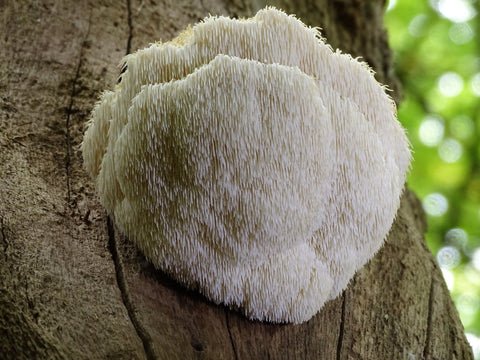
The Lion’s Mane mushroom (Hericium erinaceus) looks different from Ganoderma lucidum, but both have potential health benefits. Lion’s Mane has white, shaggy spines resembling a lion’s mane and is known for cognitive benefits, especially in brain health. While compared for different properties and benefits, they are two distinct types of mushrooms[7].
The table below highlights some of their differences:
| Characteristics | Lion’s Mane | Reishi |
| Appearance | White, shaggy, and globular in shape | Brown, flat, and kidney-shaped |
| Taste | Mild, slightly sweet, or savory | Bitter and woody |
| Medicinal Properties | May improve cognitive function, reduce inflammation, and boost the immune system | May reduce stress and anxiety, improve sleep, and boost the immune system |
| Preparation | Best eaten cooked, often used in soups, stews, and stir-fries | Best consumed as a tea or supplement, can also be added to soups or taken in capsule form |
| Growing Habitat | Grows on hardwood trees in North America, Europe, and Asia | Grows on hardwood trees in North America, Europe, and Asia |
| Cultivation Difficulty | Moderate to difficult | Easy to cultivate |
FAQs
Is Red Reishi Safe?
Yes, Red Reishi is generally considered safe when used in moderation. It has a long history of use in traditional medicine. However, it’s essential to consult with a healthcare professional before using it as a supplement, especially if you have underlying health conditions or are taking medications to ensure it won’t interact negatively.
Can You Eat Reishi Raw?
No, it’s not recommended to eat Reishi mushrooms raw. They are hard and woody in their natural form, making them difficult to digest and potentially causing stomach discomfort. To consume Reishi, it’s best to prepare them through cooking, drying, or making extracts, as this makes their beneficial compounds more accessible and easier to ingest.
Is Wild Reishi Rare?
Yes, wild Reishi mushrooms are considered rare to find. They grow naturally in moist and dark forests on decaying logs or stumps in certain parts of Asia, such as Japan, China, and Korea. Due to its small and specific growing areas, it can be mistaken for other species. As it is difficult to find and cultivate, it is usually harvested from the wild.
Are There Different Types of Reishi?
There are different types of reishi mushrooms, such as Ganoderma lucidum, Ganoderma tsugae, and Ganoderma applanatum, which vary in appearance and have unique medicinal properties. Red reishi is known to boost the immune system, white reishi may reduce stress, and black reishi may activate the body’s natural healing process.
Can Anyone Take Reishi Mushroom?
Generally, Reishi mushrooms are safe for most people when used as a dietary supplement. However, it’s wise to consult with a healthcare provider before adding them to your routine, especially if you have underlying health conditions, take medications, or are pregnant or nursing, to ensure they won’t pose any adverse effects or interactions.
Who Should Avoid Reishi?
Individuals with bleeding disorders, low blood pressure, or those taking blood-thinning medications should avoid Reishi mushrooms, as they can potentially increase the risk of bleeding. Additionally, people who are allergic to mushrooms or experience side effects like dry mouth or digestive issues should also refrain from using Reishi. Consulting a healthcare professional is advisable.
Conclusion on Reishi Mushroom Look-Alikes
It can be challenging to identify reishi mushrooms, especially for beginners. By recognizing their unique characteristics, like their shiny cap and white spots, you can differentiate them from their look-alikes. If you are uncertain about a mushroom’s identification, it is best to seek advice from an expert or buy them from a reliable source. By taking these measures, you can safely enjoy the numerous health advantages of reishi mushrooms.
References
1. A brief overview of the potential health benefits of Ganoderma lucidum. Retrieved from https://www.researchgate.net/publication/348135206_A_brief_overview_of_the_potential_health_benefits_of_Ganoderma_lucidum
2. Arora, D. (1986). Mushrooms Demystified: A Comprehensive Guide to the Fleshy Fungi. Ten Speed Press. Retrieved from https://adams.marmot.org/Record/.b10628101
3. The ITS region provides a reliable DNA barcode for identifying reishi/lingzhi (Ganoderma) from herbal supplements. Retrieved from https://www.ncbi.nlm.nih.gov/pmc/articles/PMC7660467/
4. Antioxidant, antibacterial, antitumor, antifungal, antiviral, anti-inflammatory, and nevro-protective activity of Ganoderma lucidum: An overview. Retrieved from https://www.ncbi.nlm.nih.gov/pmc/articles/PMC9353308/
5. Hobbs, C. (2013). Medicinal Mushrooms: An Exploration of Tradition, Healing, & Culture. Botanica Press. Retrieved from https://christopherhobbs.com/?s=medical+mushrooms
6. Molecular insights and cell cycle assessment upon exposure to Chaga (Inonotus obliquus) mushroom polysaccharides in zebrafish (Danio rerio) Retrieved from https://www.ncbi.nlm.nih.gov/pmc/articles/PMC7198532/
7. The Addition of Reishi and Lion’s Mane Mushroom Powder to Pasta Influences the Content of Bioactive Compounds and the Antioxidant, Potential Anti-Inflammatory, and Anticancer Properties of Pasta. Retrieved from https://www.ncbi.nlm.nih.gov/pmc/articles/PMC10044984/

